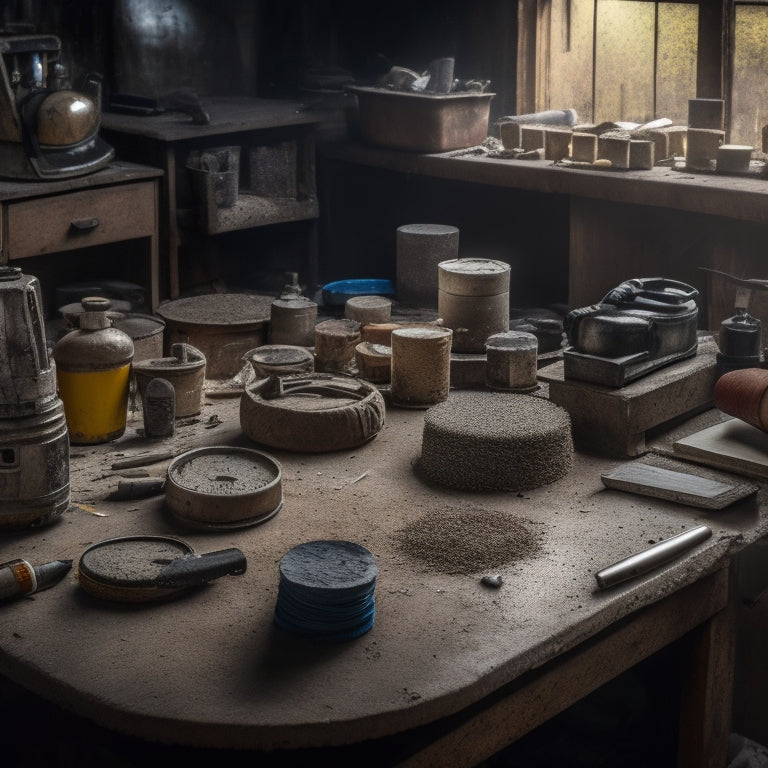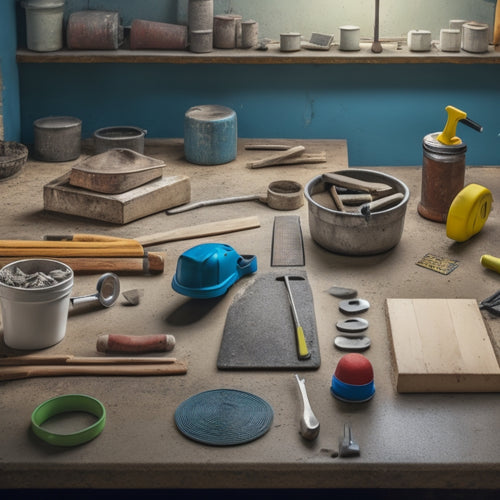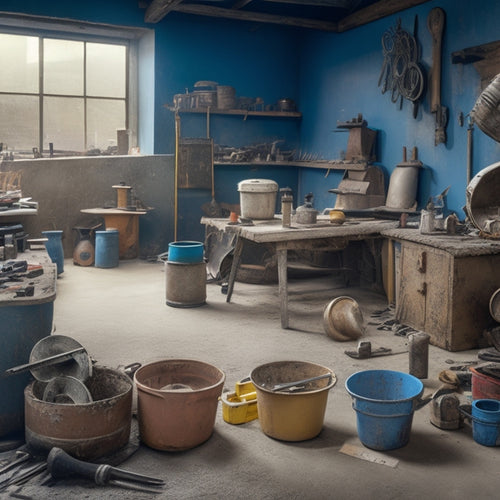
What Buffing Tools Do You Need for Concrete Walls
Share
You'll need a combination of cleaning tools, surface preparation tools, and specialized buffing tools to effectively prepare and finish concrete walls. Start with high-pressure washers, wire brushes, and degreasers for cleaning, and concrete bonding agents and floor scrapers for surface prep. Then, choose the right buffer for your specific needs, considering factors like speed, aggressiveness, and versatility. Next, select the appropriate grinding tools, such as angle grinders, diamond cup wheels, and handheld grinders, as well as polishing pads and discs. With the right tools and techniques, you'll be well on your way to achieving a high-quality finish - and there's more to explore to get the best results.
Key Takeaways
• Choose the right buffer based on speed, aggressiveness, and versatility for specific concrete wall preparation and buffing needs.
• Select the appropriate buffing head, such as steel wool, diamond-coated, or felt, depending on the desired shine level and surface condition.
• Consider electric, gas-powered, or handheld power sources for buffing tools, depending on project size, required aggression, and personal comfort.
• Diamond cup wheels and angle grinders are essential for aggressive grinding and material removal, while handheld grinders are ideal for tight spaces and detail work.
• Dust control and safety measures, including dustless buffing systems, personal protective equipment, and proper workspace organization, are crucial for a safe and efficient job site.
Essential Tools for Cinder Blocks
To effectively buff concrete walls constructed from cinder blocks, you'll need to assemble a set of specialized tools that can tackle the unique challenges of these porous, absorbent surfaces.
Cinder block preparation is key, and that involves cleaning the wall surface to remove dirt, grime, and old adhesives. You'll need a high-pressure washer or a wire brush to scrub away stubborn substances. Next, apply a concrete bonding agent to guarantee a strong bond between the wall and any subsequent coatings. For wall surface treatment, use a degreaser to remove oils and waxes that might interfere with the buffing process.
A thorough toolset should also include a floor scraper or edger to remove old coatings and level the surface. Additionally, you'll need a dustless sanding system or a vacuum-equipped sander to minimize dust and debris.
Don't forget a set of diamond-grit sanding pads in various grits to progressively smooth out the surface. Finally, invest in a high-quality buffing compound and a polishing pad to bring out the desired sheen.
With these tools, you'll be well-equipped to tackle cinder block preparation and wall surface treatment, setting the stage for a successful buffing process.
Choosing the Right Buffer
When selecting a buffer for your concrete wall project, you'll need to take into account several key factors to guarantee you're getting the right tool for the job.
You'll want to evaluate criteria such as the buffer's speed, aggressiveness, and versatility to determine which type of buffer is best suited for your specific needs.
Buffing Tool Selection Criteria
You'll need to contemplate several key factors when selecting a buffing tool for your concrete wall project, including the type of concrete, the level of shine desired, and the tool's power and speed.
For instance, if you're working with a high-strength concrete, you'll require a buffing tool with a higher torque output to effectively remove imperfections. The level of shine you desire will also influence your selection, as a higher gloss finish demands a tool with a higher RPM.
When evaluating buffing tool materials, consider durability and resistance to wear. A tool with a sturdy build and high-quality components will withstand the rigors of repeated use, reducing the need for frequent buffing tool maintenance.
Regular upkeep is still essential, however, to guarantee peak performance and extend the tool's lifespan. Look for tools with easy-to-replace parts and a design that facilitates cleaning and maintenance.
Types of Buffing Heads
Selecting the right buffing head is essential to achieving the desired finish on your concrete wall, as different heads are designed to tackle specific tasks and concrete types. You'll want to choose a head that complements your buffing techniques and suits the condition of your concrete.
Here's a breakdown of common buffing head types:
| Head Material | Suitable For | Task |
|---|---|---|
| Steel Wool | Smooth concrete, removing minor imperfections | Light polishing, cleaning |
| Diamond-Coated | Rough, damaged, or stained concrete | Aggressive grinding, removal of old coatings |
| Felt | High-gloss finishes, polishing metal, or stone | Fine polishing, honing |
When choosing a buffing head, consider the concrete's surface condition, the desired finish, and the level of aggression required. For instance, if you're working with rough, damaged concrete, a diamond-coated head is the way to go. For a high-gloss finish, felt is your best bet. By selecting the right buffing head, you'll achieve professional-looking results and optimize your buffing techniques.
Power Source Options
With the right buffing head in hand, it's time to pair it with a power source that can effectively drive it to achieve the desired results on your concrete wall.
When it comes to power source options, you're faced with a significant decision: electric vs gas. Each has its pros and cons, and it's important to take into account your specific needs and preferences.
Electric buffers offer higher power tool efficiency, reduced maintenance, and a quieter operation. They're ideal for smaller to medium-sized projects and are generally more environmentally friendly.
On the other hand, gas-powered buffers provide more torque and are better suited for larger, more demanding projects. However, they're noisier, heavier, and require more maintenance.
Think about the size of your concrete wall, the level of aggression required, and your personal comfort level with noise and vibration.
Angle Grinders for Concrete
When you're working with angle grinders for concrete, you'll need to focus on three key aspects to achieve ideal results.
First, you'll select the right grinder bit for your specific task, considering factors like grit and bond type.
Next, you'll master angle control techniques to maintain even contact and prevent damage.
Grinder Bit Selection
You'll need to equip your angle grinder with the right bit to effectively grind and smooth out concrete walls, and that means choosing from a variety of grinder bits specifically designed for concrete. The right grinder bit can make all the difference in achieving a smooth, even finish.
When selecting a grinder bit, consider the material. Diamond-coated bits are ideal for concrete, as they provide aggressive grinding and long lifespan. Carbide-tipped bits, on the other hand, are better suited for lighter concrete grinding tasks.
You'll also need to decide on the right size. Grinder bits come in various sizes, ranging from 4 to 12 inches in diameter. Larger bits are ideal for covering more surface area, while smaller bits are better for precision work and getting into tight spaces.
Choose a grinder bit that matches the specific requirements of your project. Consider the level of aggression needed, the size of the area to be ground, and the type of concrete you're working with.
Angle Control Techniques
Selecting the right grinder bit is only half the battle; now it's crucial to master the angle control techniques that'll help you wield your angle grinder with precision and confidence on concrete walls.
As you take on the challenge of buffing concrete, you'll need to develop angle adjustment techniques that allow you to tackle different surfaces and textures with ease.
It's essential to understand that the buffing angle you use will directly impact the results you achieve.
Dust Reduction Methods
To minimize the hazardous effects of airborne silica dust and improve overall job site safety, effective dust reduction methods are essential when operating angle grinders on concrete walls.
You'll want to prioritize dust control to reduce the risk of respiratory issues and other health problems associated with silica exposure.
One effective method is to use a vacuum-equipped dust collection system, which captures dust particles at the source, reducing airborne particles by up to 90%.
Additionally, consider investing in an air filtration system, which can further minimize the amount of dust particles in the air.
Another vital step is to wear personal protective equipment (PPE), such as respirators and dust masks, to prevent inhalation of silica dust.
By implementing these dust reduction methods, you'll not only protect yourself and your team but also guarantee a cleaner, more efficient work environment.
Diamond Cup Wheels Explained
What sets diamond cup wheels apart from other buffing tools is their unique design, featuring a series of diamond-coated segments arranged in a cup shape. This design allows for aggressive material removal and efficient concrete wall preparation.
You'll find that diamond cup wheels are ideal for heavy-duty concrete grinding, surface preparation, and coating removal. The diamond-coated segments come in various grit types, including coarse, medium, and fine, each suited for specific applications.
Coarse grits (16-24) are perfect for heavy material removal, while medium grits (30-60) are better suited for general-purpose grinding. Fine grits (80-120) are ideal for polishing and finishing.
When it comes to cup wheel applications, you'll appreciate their versatility. They can be used on walk-behind grinders, ride-on grinders, or even handheld grinders for more precise work.
Diamond cup wheels are also effective for removing old coatings, epoxy, or paint, and for preparing surfaces for new coatings or overlays. With the right diamond cup wheel, you'll be able to tackle even the toughest concrete wall preparation tasks with ease and confidence.
Handheld Grinders for Detail
How do you tackle tight spaces and intricate details on concrete walls when diamond cup wheels are too large for the job? That's where handheld grinders come in - the ultimate solution for detail enhancement in confined areas.
These powerful tools offer handheld versatility, allowing you to precision-craft and refine even the most intricate details. With their compact size and lightweight design, you can navigate tight spaces with ease, effortlessly maneuvering around corners, edges, and curves.
Handheld grinders are specifically designed for detail work, providing unmatched control and accuracy. Their high-torque motors and precision-engineered grinding heads facilitate efficient removal of material, while their ergonomic grips reduce fatigue and improve handling.
Whether you're working on decorative concrete, polishing small areas, or removing imperfections, handheld grinders are the perfect tool for the task. By incorporating handheld grinders into your arsenal, you'll be able to tackle even the most demanding detail work with confidence, precision, and power.
Concrete Scarifier Options
Three concrete scarifier options are available for tackling rough, uneven surfaces and removing thick coatings: electric, pneumatic, and hydraulic models, each with its unique benefits and applications.
As you consider which scarifier type to use, think about the specific challenges you're facing.
Electric scarifiers are ideal for smaller areas and offer more control, making them perfect for delicate surfaces.
Pneumatic scarifiers, on the other hand, provide more power and are suitable for larger areas. They're also more cost-effective in the long run.
Hydraulic scarifiers are the most powerful of the three and are typically used for heavy-duty applications, such as removing thick epoxy coatings.
When choosing a scarifier, consider the scarifier benefits that matter most to you. Do you need precision, power, or cost-effectiveness?
Each type of scarifier has its strengths, and selecting the right one will guarantee you get the results you need.
Dustless Buffing Systems
After removing thick coatings and uneven surfaces with a concrete scarifier, you'll likely need to refine the surface further, which is where dustless buffing systems come in, offering a controlled and contained way to polish and finish your concrete walls. These systems utilize dustless technology, which captures and contains dust and debris, providing a cleaner and healthier work environment. This not only benefits you and your team but also provides significant environmental benefits by reducing airborne pollutants.
Here's a breakdown of the key components of a dustless buffing system:
| Component | Description | Benefit |
|---|---|---|
| Dustless Grinder | A specialized grinder that captures dust and debris | Reduces airborne pollutants |
| Vacuum System | A high-powered vacuum that extracts dust and debris | Improves air quality |
| Dust Containment | A sealed system that prevents dust from escaping | Minimizes mess and cleanup |
Polishing Pads and Discs
You'll need a range of polishing pads and discs to achieve the desired level of shine and smoothness on your concrete walls. These tools are essential for surface preparation and polishing techniques. The right combination of pads and discs will help you remove imperfections, fill in scratches, and bring out the natural beauty of the concrete.
Here are some key considerations when selecting polishing pads and discs:
-
Grit level: Choose pads and discs with varying grit levels to progress from coarse to fine polishing.
-
Material type: Select pads and discs designed for concrete, as they're formulated to effectively remove imperfections and scratches.
-
Pad shape and size: Use pads and discs in various shapes and sizes to access tight spaces and cover large areas.
- Bond type: Opt for pads and discs with a suitable bond type to guarantee effective polishing and minimize wear and tear.
Safety Equipment for Buffing
As you move on to the polishing stage, don't forget to gear up with the right safety equipment to protect yourself from the hazards of buffing concrete walls.
You'll need personal protective gear, such as gloves, safety glasses, and a dust mask, to shield yourself from abrasive particles and dust.
Don't overlook a pair of sturdy work boots with good traction to prevent slips and falls.
Proper workspace organization is also essential for a safe and efficient buffing process.
Keep your workspace clean and clear of clutter to prevent tripping hazards and ensure easy access to your tools.
A well-organized workspace also helps you stay focused on the task at hand, reducing the risk of accidents.
Additionally, consider investing in a dust collector or vacuum system to minimize airborne particles and prevent respiratory issues.
By prioritizing safety equipment and workspace organization, you'll be able to tackle even the toughest buffing projects with confidence and precision.
Frequently Asked Questions
Can I Use a Buffer on Freshly Poured Concrete Walls?
Don't even think about using a buffer on freshly poured concrete walls.
You'll ruin the surface and compromise the concrete curing process.
Wait until the concrete has fully cured, which can take up to 28 days, depending on the mix and environmental conditions.
Then, and only then, can you start applying buffering techniques to achieve the desired finish.
How Often Should I Replace Buffing Pads for Optimal Results?
Are you willing to sacrifice the quality of your concrete walls for the sake of convenience? Don't even think about it!
To achieve ideal results, you need to replace buffing pads regularly. The buffing pad lifespan depends on usage, but as a rule of thumb, you should swap them out every 3-5 uses.
Neglecting to do so can lead to subpar finishes and even damage to your walls.
Stick to an ideal buffing frequency, and you'll be rewarded with a flawless concrete surface that exudes power and sophistication.
Are Dustless Buffing Systems Worth the Extra Investment?
You're wondering if dustless buffing systems are worth the extra investment. The answer is yes, they're a game-changer.
Dustless technology reduces airborne particles, making your work environment safer and more efficient. While the upfront cost may be higher, the cost benefits will pay off in the long run.
You'll spend less on cleanup, reduce the risk of respiratory issues, and increase productivity. It's a worthwhile investment that'll take your buffing game to the next level.
Can I Use a Buffer to Remove Old Paint From Concrete Walls?
When tackling old paint removal from concrete walls, you're likely wondering if a buffer is the right tool for the job. Yes, it can be!
Choose a buffer specifically designed for paint removal, such as a floor buffer or a rotary drum sander. These buffer types excel at scraping off old paint, especially when paired with the right abrasives.
Effective paint removal techniques involve working in sections, applying moderate pressure, and gradually increasing grit for a smooth finish.
Do I Need to Seal My Concrete Walls After Buffing?
Fresh from fierce floor friction, you're now faced with the finale: sealing.
Should you seal your concrete walls after buffing? Absolutely! Sealing releases superior shielding, safeguarding your walls from stains, scratches, and fading.
This savvy step also simplifies concrete wall maintenance, making future cleanups a breeze.
Conclusion
As you begin the journey to tame the rugged beast that's your concrete wall, remember the wise words of Michelangelo: 'The true work of art is but a shadow of the divine perfection.'
With the right arsenal of buffing tools, you'll be well on your way to releasing the hidden beauty within. From angle grinders to polishing pads, each tool is a brushstroke on the canvas of your concrete masterpiece.
Now, get ready to create your own work of art.
Related Posts
-

Must-Have Tools for Laying Concrete Tiles
When laying concrete tiles, you'll need a range of essential tools to get the job done right. Start with subfloor pre...
-

3 Best Hand Tools for DIY Concrete Construction
When tackling a DIY concrete construction project, you'll need three essential hand tools to achieve a professional-l...
-

Best Tools for Concrete Restoration and Repair
When tackling concrete restoration and repair projects, you need a range of reliable tools to achieve professional-gr...


